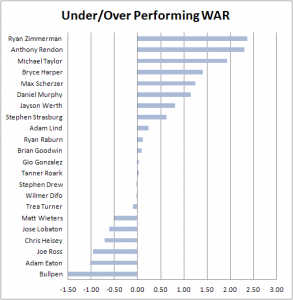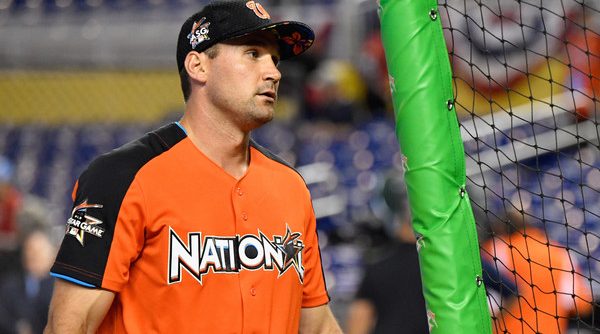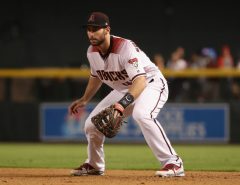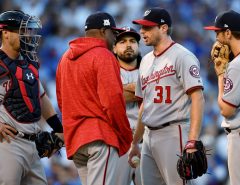The Nationals kick off the second half of the 2017 season tonight on the road against the Reds sitting 9.5 games up in the NL East. While the squad has sat in first place for practically the entire season, it hasn’t been an easy road getting there. Some players have outplayed their expectations while others have been disappointing so far this season.
Rather than trust our gut, we are going to approach the question of who has overperformed or underperformed scientifically. The starting point will be the ZiPS projections posted at the start of the year at FanGraphs. Using the actual Wins Above Replacement (WAR) from FanGraphs, we will calculate the difference in expected WAR between projections and actual and spit out the results in a nifty graph below. Bars to the right are positive (i.e. higher WAR at the halfway point of the year than ZiPS projected) while bars to the left are negative (accrued less WAR so far this season than projected):

Let’s start with the worst and most obvious underperformers: the bullpen. ZiPS thought that Mike Rizzo had actually pulled together a solid outfit, projecting them to have earned just over 2.0 WAR at the halfway point of the year. Instead, the group has been worth -1.0 WAR. I’m tired of talking about the bullpen, you are tired of talking about the bullpen, so let’s move up the chart to happier things.
Ok, I lied. The next one isn’t happy at all, but at least it’s expected. Adam Eaton was projected to be a big part of the 2017 Nationals season. And for 23 games, he was everything the Nationals hoped for and more. Until he caught the edge of the first base and wound up with a torn ACL, that is. So while Eaton is the largest individual “underperformer” according to the math, no one will fault him for winding up at the bottom of the chart.
Joe Ross has a sparkly 5-3 record on the year, but he’s the poster boy for the “kill the pitcher win” crowd as the third-biggest underperformer. He has an ERA over 5.00, has already been demoted to the minors once and has struggled to reach even the fifth inning in a lot of his starts. As the Nationals look to address their bullpen woes, Ross’ role as a starter is no guarantee. If the Nationals decide to add another starting pitcher between now and trade deadline, look for Ross to take a stab at steadying the shaky bullpen.
Oh the catchers. Jose Lobaton went from everyone’s favorite quirky, capable backup catcher to everyone’s favorite punching bag pretty quickly it seems. Rightfully so, perhaps, as he has the second lowest WAR of all Nationals at the break. He’s been terrible with the bat and his usually reliable glove appears to have abandoned him. But Lobaton hasn’t been the only disappointing catcher donning the Curly W. Matt Wieters has underperformed his projections almost as badly as Lobaton so far this season. Despite a hot start, Wieters’ bat has abandoned him and as a result he’s been basically a 0.0 WAR player on the season.
Enough of the bad, let’s get to some highlights! The performance of Ryan Raburn and Adam Lind is a testament to Mike Rizzo’s ability to find value in the bargain bin. Brought on in the offseason to replace Clint Robinson as the designated left-handed power bat off the bench, Lind has played his role to perfection. He’s already surpassed his projected WAR for the season and seems likely to continue mashing as long as Dusty Baker keeps finding him at bats against right handed pitching. Raburn, on the other hand, was an audible called by Rizzo after Jayson Werth hit the DL. The flip side to Lind, Raburn is a specialist who hits lefties and has also served his purpose well. He probably won’t have a roster spot once Werth returns to action, so take the chance now to appreciate what he’s done.
The seasons of Michael A. Taylor and Brian Goodwin have taken a similar path. Both started their professional careers with high expectations only to stumble as they approached their big-league opportunities. 2017 appears to be the year that they both make good on the expectations some held for them. Given the chance at regular playing time thanks to injury, Goodwin and Taylor have seized their opportunities and outperformed the meager expectations heading into the season.
It’s no surprise to see Max Scherzer and Stephen Strasburg rate so highly here, but perhaps it should be. ZiPS had pretty high hopes for the pair of pitchers, projecting Scherzer for nearly 6.0 WAR on the year and Strasburg for over 4.0 WAR. Yet the duo has somehow outperformed those lofty goals. If they keep it up, Scherzer could bring home his third Cy Young award and Strasburg might finally get a chance to dominate in the playoffs.
Daniel Murphy and Bryce Harper deserve shout outs for similar reasons. They were projected to be two of the Nationals best players coming into the year, but both of them have still outperformed expectations. Murphy’s new swing continues to prove the doubters wrong, and Harper has bounced back from a disappointing year to return to his place as one of the best hitters in baseball.
Quick shout out to Anthony Rendon, the Nationals non-All Star, All Star. Again, the projection system didn’t think Rendon was a bum — he’s just been that good this year. In fact, he’s leading the Nationals in WAR. At least we know Rendon was happier doing whatever he did over his All Star break than he would have been in the limelight at the ASG.
Finally, the Ryan Zimmerman renaissance. Unlike the rest of the Nationals outperformers, ZiPS hated Zimmerman. He was projected to be the worst position player on the Nationals in 2017, and it’s not hard to understand why. Finally healthy, Zimmerman has returned to the form that made him the original face of the franchise, making him the biggest outperformer in the first half of the season.
Tags: Adam Eaton, Adam Lind, Anthony Rendon, Brian Goodwin, Bryce Harper, Daniel Murphy, Jose Lobaton, Matt Wieters, Max Scherzer, Michael Taylor, Nationals, Nats, Ryan Raburn, Ryan Zimmerman, Stephen Strasburg, Washington Nationals




Leave a Reply